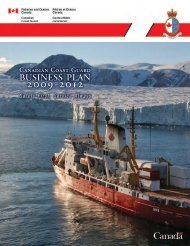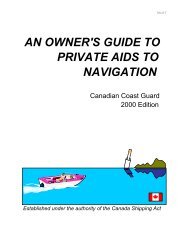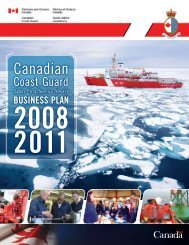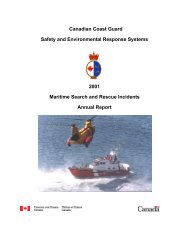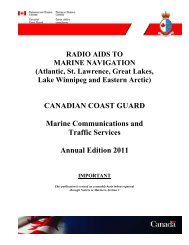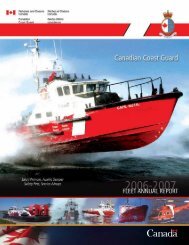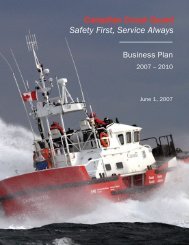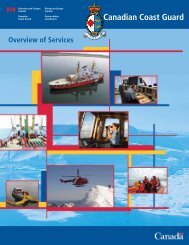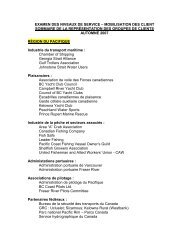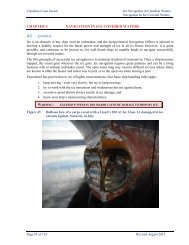PART 4 - Canadian Coast Guard
PART 4 - Canadian Coast Guard
PART 4 - Canadian Coast Guard
You also want an ePaper? Increase the reach of your titles
YUMPU automatically turns print PDFs into web optimized ePapers that Google loves.
Time Signals<br />
Canada’s official time is the responsibility of the National Research Council’s Institute for National Measurement<br />
Standards, Ottawa, ON Its short wave radio station CHU, with transmitters located at 45º17’47”N 75º45‘22”W is<br />
equipped with vertical antennas to give the best possible coverage to the maximum number of <strong>Canadian</strong> users. The signal<br />
is transmitted continuously on 3330 kHz, 7850 kHz and 14,670 kHz, upper single-sideband H3E (AM compatible). A<br />
cesium atomic clock generates the carrier frequencies (accurate to a part in 10 11 ) and the UTC seconds pulses (accurate to<br />
50 microseconds). The start of each UTC second is marked by the start of 300 cycles of a 1000 Hz tone, with certain<br />
omissions and identifications. Every half-minute is marked by omitting the preceding tone (for second 29). In the<br />
9 seconds preceding each minute, the second pulses are shortened to “ticks’ to provide a window for the voice<br />
announcement, followed by a longer tone. The start of this tone marks the exact minute given by the announcement. This<br />
tone is one-half second long, except for the exact hour - when it is one full second long and in this case only is followed by<br />
9 seconds of silence.<br />
The bilingual voice announcement which is heard each minute takes the form:<br />
“CHU Canada - Coordinated Universal Time -- hours -- minutes -- heures -- minutes” for even minutes,<br />
and<br />
“CHU Canada - Temps Universel Coordonné -- heures -- minutes -- hours -- minutes” for odd minutes.<br />
A small number of the longer time announcements use the abbreviation “UTC’ rather than the full form.<br />
Following international practice, Canada’s official time is based on Coordinated Universal Time (UTC) which is kept<br />
within one second of UT1, the time on the Greenwich meridian as used for celestial navigation. Users interested in the<br />
ultimate accuracy of celestial navigation can determine UT1 with an accuracy of 0.1 seconds by decoding the difference<br />
DUT1 = UT1 - UTC, as transmitted by CHU in the internationally accepted code. The number of tenths of a second of<br />
DUT1 can be decoded by counting the number of emphasized second pulses that follow each minute. If the emphasized<br />
pulses occur for any of the seconds 1 to 8, DUT1 is positive; if the emphasized pulses occur for any of the seconds 9 to 16,<br />
DUT1 is negative. CHU emphasizes second pulses by splitting them (0.1 s of tone, 0.1 s of silence, 0.1 s of tone) so that a<br />
double tone is heard.<br />
DISTRESS COMMUNICATIONS IN RADIOTELEPHONY<br />
EARLY NOTIFICATION OF SEARCH AND RESCUE AUTHORITIES OF DEVELOPING SITUATIONS<br />
In the interest of ensuring the highest level of safety, mariners should immediately notify the <strong>Canadian</strong> <strong>Coast</strong> <strong>Guard</strong>,<br />
through any MCTS Centre of any situation which is or may be developing into a more serious situation requiring assistance<br />
from the Search and Rescue (SAR) System. The need for the earliest possible alerting of SAR Authorities to potential<br />
maritime emergencies cannot be over-emphasized.<br />
This advice is given in accordance with IMO Circular MSC/Circ.892 and similar advice found in the ICAO/IMO<br />
International Aeronautical and Maritime SAR (IAMSAR) Manual Volume III. Further, there have been similar<br />
recommendations arising from serious SAR cases in the <strong>Canadian</strong> SAR Region where masters have failed to provide this<br />
notice until after the situation deteriorated.<br />
This notification allows SAR authorities to carry out preliminary and contingency planning that could make a critical<br />
difference if the situation worsens. Time lost in the initial stages of a SAR mission may be crucial to its eventual outcome.<br />
It is always best to consider the “worst-case scenario” and to alert SAR authorities accordingly. This notification places no<br />
obligations upon the master except to advise the <strong>Canadian</strong> <strong>Coast</strong> <strong>Guard</strong> when the situation has been corrected.<br />
<strong>Canadian</strong> MCTS Centres provide coverage of all marine distress frequencies, however, each Centre does not necessarily<br />
guard each frequency (refer to Centre listings Part 2). MCTS provides co-ordination between the JRCC/MRSC and the<br />
vessel or vessels concerned with the distress.<br />
4-4



